
a web page by Don Roberson |
WHYDAHS & INDIGOBIRDS Viduidae |
||||||||
|
||||||||
|
||||||||
| Another four species in the family are whydahs, plus the plain dull-yellow Cuckoo Finch, round out half of the family. The remaining ten species are indigobirds. All are very similar with all-black-plumaged males and very dull streaky females. Yet, as discussed below, all of the family are fascinating parasitic species. Here are two marginal photos of male indigobirds in Mole NP, Ghana: Village Indigobird (below left) and Wilson's (or Pale-winged) Indigobird (below right). Both were feeding near each other in fruiting trees and grasses underneath. The Village Indigobird is all-black with a dull whitish bill and reddish legs. Wilson's Indigobird is essentially identical in size and is white-billed, but the legs are duller purple-pink and there is a "pale panel" formed by browner outer secondaries and primaries (marginally visible in the photo below right). Not really all that much to go on. | ||||||||
|
||||||||
What makes indigobirds most fascinating — indeed, makes all the Viduidae of interest — is their parasitic lifestyle. All members of the Viduidae are brood parasites. They evolved from small finch-like ancestors and diverged into two families about 20 million years ago: the Estrildidae (waxbills, firefinches & relatives) and the Viduidae. In short, within one evolutionary clade, some species began to parasitize their close relatives by laying eggs in the relative's nest and having the relative raise the young — quite an amazing biological adaptation. [It is easy enough to anthropomorphize the concept if your family has ever had to raise a difficult cousin . . . but we digress.] The two 'types' of small birds — one parasitic and one the unwitting host — have followed separate evolutionary paths for 20 million years (summary in Payne 2010). Each species parasitizes specific hosts. Village Indigobird, for example, primarily parasitizes Red-billed Firefinch Lagonosticta senegala (although will parasitize other firefinches in some circumstances) and does so by mimicking the song of the host species. The male attracts females with singing and hovering displays. After mating, females lay eggs that mimic the color of the host's eggs (a female may even remove some firefinch eggs). When the young indigobirds hatch, they beg with open mouths that have the same pattern of spots as those inside the mouth as the host's young. By these subterfuges, each generation of indigobird is raised entirely by their hosts. Wilson's Indigobird V. wilsoni parasitizes Bar-breasted Firefinch Lagonosticta rufpictua; Quailfinch Indigobird V. nigeriae parasitizes Black-faced Quailfinch Ortygospiza atricollis; Jos Plateau Indigobird V. maryae (an endemic northern Nigeria and n. Cameroon) parasitizes Rock Firefinch Lagonosticta sanguinodorsalis; Jambandu Indigobird V. raricola (with very patchy distribution) parasitizes Zebra Waxbill Amandava subfalva; Barka Indigobird V. larvaticola parasitizes Black-faced Firefinch Lagonosticta larvata; Cameroon Indigobird V. camerunensis parasitizes several scarce hosts species [African Firefinch L. rubricata in north Africa plus Black-bellied Firefinch L. rara, Brown Twinspot Clytospiza monteiri, and Dybrowski's Twinspot Euschistospiza dybowskii]; Dusky Indigobird V. funerea parasitizes African Firefinch L. rubricata in south & east Africa); Purple Indigobird V. purpurascens parasitizes Jameson's Firefinch L. rhodopareia; and Green Indigobird V. codringtoni parasitizes mostly Peter's Twinspot Hypargos niveoguttatus. Of course it is not quite this simple, and cases of "host switching" and probable hybridization are known; for much more see Payne (1973, 2005, 2010). |
||||||||
|
||||||||
The paradise-whydahs also have specific hosts. The widespread Eastern Paradise-Whydah V. paradisaea focuses primarily on Green-winged Pytilia (Melba Finch) Pytilia melba, although apparently may sometimes also parasitize various cordon-bleus Uraeginthus. The Sahel Paradise-Whydah V. orientalis also uses Melba Finch as its host. Broad-tailed Paradise-Whydah V. obtusa parasitizes Orange-winged Pytilia P. afra; Exclamatory Paradise-Whydah V. interjecta parasitizes Red-winged Pytilia P. phoenicoptera; and Togo Paradise-Whydah V. togoensis presumably parasitizes Yellow-winged Pytilia P. hypogrammica. In short, paradise-whydahs chose nesting pytilias as hosts. |
||||||||
The host of Pin-tailed Whydah are primarily waxbills. Quite a number of species have been identified as hosts, but those species frequently filling the role of parent include Common Waxbill Estrilda astrild, Orange-cheeked Waxbill E. meloda, Fawn-breasted Waxbill E. paludicola, and Black-rumped Waxbill E. troglodytes. In southern Africa, the primary hosts are Common Waxbill and Swee Waxbill Coccopgyia melanotis. Despite the long evolutionary history of brood-parastism on estrildid hosts, there does not seem to be an impact on populations of the host finches. In many places both whydahs and their hosts remain stable and reasonably common. |
||||||||
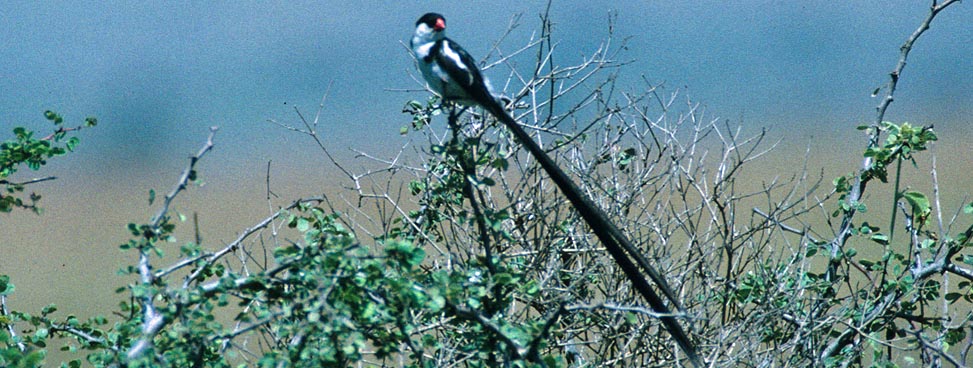 |
||||||||
|
||||||||
The remaining three whydahs are Steel-blue Whydah Vidua hypocherina and Straw-tailed Whydah V. fischeri — both from the Horn of Africa region — and Shaft-tailed Whydah V. regia of thornscrub and acacia savanna in and around the Kalahari Desert region of southern Africa. Steel-blue Whydah parasitizes Black-faced Waxbill E. erythronotos. Shaft-tailed Whydah uses Black-faced Waxbill, but also Violet-eared Waxbill Granatina granatina and Blue Cordonbleu Uraeginthus angolensis. The hosts of Straw-tailed Whydah are Blue-capped Cordonbleu U. cyanocephalus and Purple Grenadier Granatina ianthinogaster. The little-known and rarely observed Cuckoo Finch Anomalospiza imberbis has a wide variety of hosts where it occurs in Africa, but none of them are estrilid finches. Instead it focuses on cisticolas and prinias. It breeds during the rainy season — as do the host species — and the timing of nesting thus varies from site to site. |
||||||||
Photos: The male Togo Paradise-Whydah Vidua togoensis at Mole NP, Ghana, on 12 Dec 2013. The male Exclamatory Paradise-Whydah V. interjecta was photograph in Mole NP the next day. Likewise, the male Village Indigobird V. chalybeata and the male Wilson's Indigobird V. wilsoni were in Mole NP, Ghana, on 12 Dec 2013 — and very close to the spot the Togo Paradise-Whydah was photographed. W. Ed Harper photographed the breeding male Pin-tailed Whydah V. macroura in Kenya in August 1994; I photographed the non-breeding male at La Lope Reserve, Gabon, in July 1996. The various estrildid host species shown are: a male Red-billed Firefinch Lagonosticta senegala and a male Black-faced Quailfinch Ortygospiza atricollis, both from Nasia River overflow wetlands, Ghana, on 16 Dec 2013; a female Green-winged Pytilia Pytilia melba from Waterburg NP, Namibia, in July 2005, and a female Red-winged Pytilia P. phoenicoptera from Mole NP, Ghana, on 12 Dec 2013; a male Orange-cheeked Waxbill Estrilid melodia from near Kakum NP, Ghana, on 1 Dec 2013; and a male Swee Waxbill Coccopgyia melanotis from the Kirstenbosch Gardens, Cape Town, South Africa, on 3 July 2005. Photos © Don Roberson, except that credited to W. Ed Harper, who holds that copyright, and used with permission; all rights reserved. Bibliographic note: There is no "family book" per se, but a fine introduction to this family, with some wonderful photos, is in Payne (2010a). Literature cited:
|


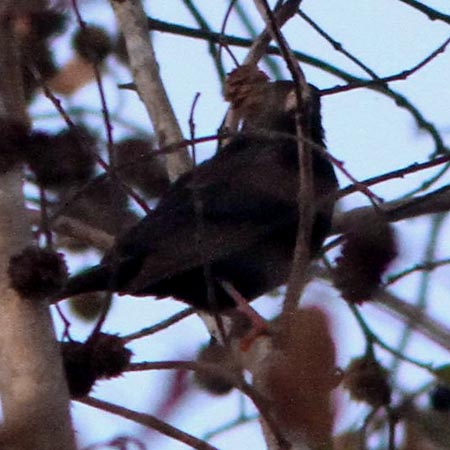
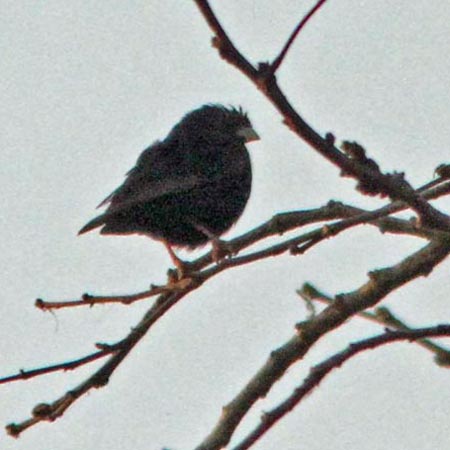
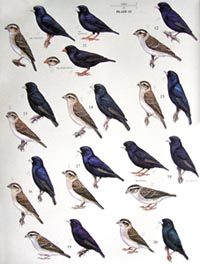 Hilary Burn's plate from Handbook of the Birds of the World
(Payne 2010a) illustrates oh-so-well just how remarkably uniform the
indigobirds are [right; there are 13 black males because the plate
illustrates 3 additional races within the ten species; for example,
some members of race amauropteryx have red bills]. It is also fascinating to learn that indigobirds evolved from ancestors which had long tails (Fry 2010).
Hilary Burn's plate from Handbook of the Birds of the World
(Payne 2010a) illustrates oh-so-well just how remarkably uniform the
indigobirds are [right; there are 13 black males because the plate
illustrates 3 additional races within the ten species; for example,
some members of race amauropteryx have red bills]. It is also fascinating to learn that indigobirds evolved from ancestors which had long tails (Fry 2010). 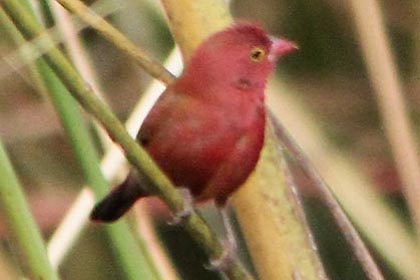
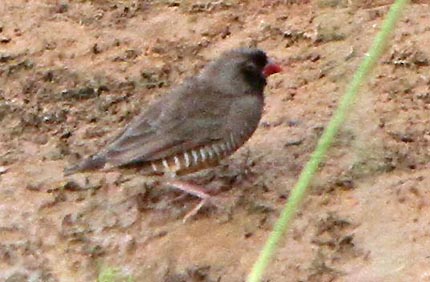
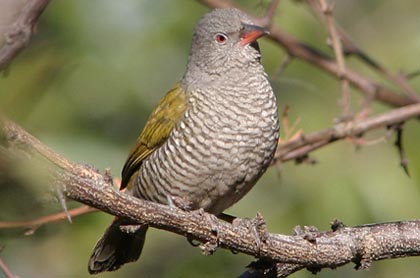

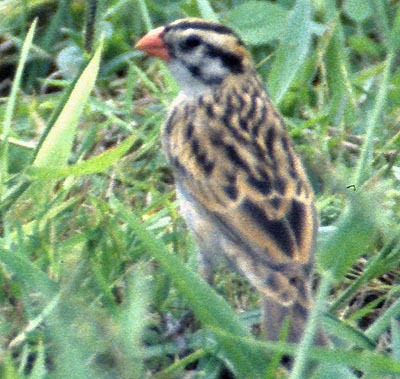 A very common and widespread species — essentially everywhere in sub-Saharan Africa except some deserts and highlands — is Pin-tailed Whydah
(male in breeding plumage shown below, a photo from Kenya by Ed
Harper). Outside the breeding season the males lose the long tails and
pied pattern, and revert to a small, colorful, red-billed sparrow-like
bird (right). Females are even less patterned and mostly dark-billed
throughout the year. Having evolved from estrildid-like ancestors, all
the whydahs and indigobirds are seed-eaters, often foraging in weed
fields and grassy patches along with their host species.
A very common and widespread species — essentially everywhere in sub-Saharan Africa except some deserts and highlands — is Pin-tailed Whydah
(male in breeding plumage shown below, a photo from Kenya by Ed
Harper). Outside the breeding season the males lose the long tails and
pied pattern, and revert to a small, colorful, red-billed sparrow-like
bird (right). Females are even less patterned and mostly dark-billed
throughout the year. Having evolved from estrildid-like ancestors, all
the whydahs and indigobirds are seed-eaters, often foraging in weed
fields and grassy patches along with their host species.
